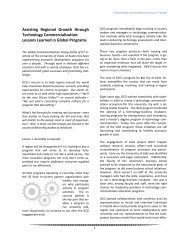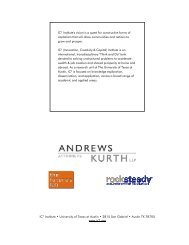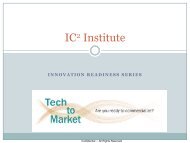“Quicklook” Assessment of Greater Adelaide's Assets & Challenges ...
“Quicklook” Assessment of Greater Adelaide's Assets & Challenges ...
“Quicklook” Assessment of Greater Adelaide's Assets & Challenges ...
You also want an ePaper? Increase the reach of your titles
YUMPU automatically turns print PDFs into web optimized ePapers that Google loves.
• Barriers <strong>of</strong> getting products into their own hospitals<br />
o Multinationals can bundle more than one product together – smaller<br />
companies in SA cannot do this and are blocked out<br />
o They have not invested in developing relationships with hospitals.<br />
Sometimes they just lack business savvy.<br />
o Go to clinician to get them to help develop next generation products.<br />
• Example: local manufacturing making titanium, but they import instead<br />
at double the costs(tall poppy syndrome because one <strong>of</strong> the owners is<br />
one <strong>of</strong> the surgeons that does the surgery – the doctor should sell his<br />
portion <strong>of</strong> the company)<br />
o People prefer to buy locally if they can, but this doesn’t cover the health<br />
sector.<br />
o A few years ago they lauched a campaign to ‘buy Australian’ but there<br />
was a ZERO result in sales increase.<br />
o Dick Smith is raising the pr<strong>of</strong>ile again for Australian products. Extortion<br />
threat against a company called Heron – Panadol was the other product<br />
(but it is still made in Australia). This has focused the media on the issue<br />
again. At the end <strong>of</strong> the day, the quality needs to be as good and the<br />
price comparable.<br />
Dynek Case Study<br />
Patricia ????? started Dynek with $3k and an idea – came out <strong>of</strong> Johnson and Johnson<br />
(she is a salesperson).<br />
• Thought the market was easy but quickly learned that they were “treading on the<br />
hallowed ground <strong>of</strong> large multi-nationals”<br />
• Realized that they would have to go global quickly in order to survive. Started in<br />
1974.<br />
• Australia didn’t understand that they should support health issues here – still on<br />
going because <strong>of</strong> large importing. Attitiude was that Aussie goods aren’t good<br />
quality (here in Australia).<br />
• Manufacturing base is not great – overcome that now – they are CE marked, but<br />
have not worried about FDA just yet.<br />
• Issue was that they had a good quality product, but was not recognized here until<br />
2 yrs ago. They tend to specialize and find a niche market – go in low under<br />
radar.<br />
• 1993, the Brown govt (liberal) came in and invited her on the SA development<br />
council. Talked about what they could do about small businesses. Patricia was<br />
the one talking to them about health being a significant business “health is wealth”<br />
• They gave her money to make a video (but attitude was, fine, but you will have<br />
problems finding enough health industries) – in actuality they could have done a<br />
miniseries! They have identified 24 industries.<br />
• Finally, she convinced them that ‘health is wealth’ and they did some statistics on<br />
health. In the 3 areas on the video, they found that there was a $2 B market.<br />
• They have talked about changing the name ‘health’ to ‘wellness’<br />
• The council was disbanded because it became too powerful. So it changed from<br />
SA development council and it turned to Business Vision 2010. Patricia is<br />
potentially going to be president <strong>of</strong> the business council.<br />
• Women are starting to make inroads into government (CEO <strong>of</strong> city council, etc.)<br />
COMMERCIAL IN CONFIDENCE<br />
80





